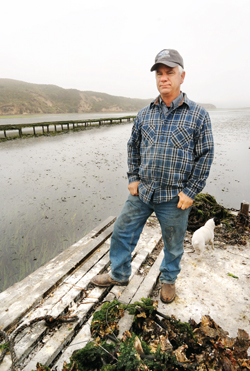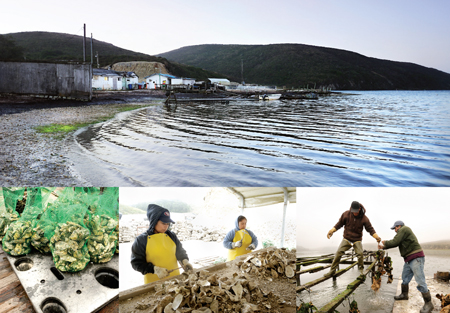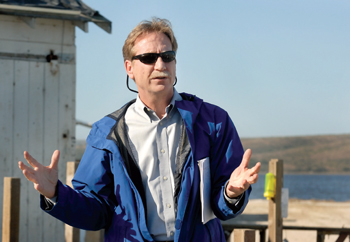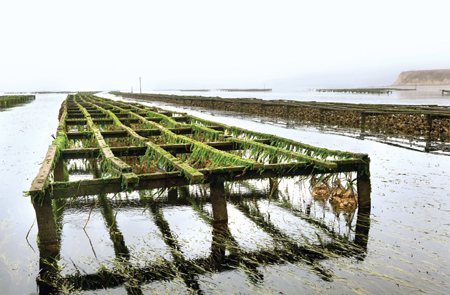What started as a favor between two Point Reyes farmers has turned into a briny brawl that has spilled out of the backwaters of West Marin into the offices of Sen. Dianne Feinstein, triggered one federal investigation into accusations of scientific malfeasance and launched another into the environmental health of one of California’s most treasured bodies of water, Drakes Estero on the Point Reyes National Seashore.
The National Park Service and wilderness advocates are at loggerheads with rancher Kevin Lunny over the long-term fate of his Drakes Bay Oyster Co. The park wants to shut it down in 2012 when its lease runs out; Lunny, the latest in 80 years of oyster farmers on the site, wants to keep it going after that.
At the core is a double-barreled debate as tangled as the life-sustaining eelgrass in Drakes Estero both sides say they seek to protect. One issue involves congressional intent, the other allegations that Lunny is doing environmental harm, assertions Lunny and his scientific backers refute.
Lunny didn’t see all this fuss coming when Tom Johnson, a longtime friend, approached him and his brothers for help in mid-2004. Johnson had inherited Johnson’s Oyster Company from his father, Charlie, who was as much of a West Marin landmark as his well-weathered oyster shack.
“Tom had a good heart, but the walls were caving in on him and the regulations were driving him into financial ruin,” Lunny says. Johnson needed the equipment the Lunnys owned for its Nicasio grading and paving company to clean up the site. “He wasn’t able to pay, but we said, ‘let’s not sweat the small stuff,’ ” Lunny says.
A short time later, Johnson asked the Lunnys if they wanted to take over the remainder of the oyster company’s 40-year agreement with the park service, called a Reservation of Use and Occupancy (RUO). It was a provocative challenge.
“Frankly, we knew the oyster farm was Don’s biggest headache before we purchased the balance of the RUO,” Lunny says, referring to Don Neubacher, superintendent of the Point Reyes National Seashore. Lunny recalls telling his wife, Nancy, and his brothers, “The only way we can explore the idea is if Don supports it. If he’s against it, it’d be an uphill battle and we’ll never do it.”
Neubacher, he says, was supportive, “but told me he didn’t plan to extend the RUO. By then we had done enough homework to be reasonably sure that he could,” Lunny says. “I thought if we proved that we could solve all the environmental problems the park would issue a special permit to allow oyster farming beyond 2012.”
The Lunny family borrowed a million dollars to clean up the site and improve oyster production. They changed the name to Drakes Bay Oyster Co. “We were really excited,” Lunny says.
Boots and a BlackBerry
Lunny and his three children are the third and fourth generations of his family to live on the 1,400-acre G Ranch, one of 15 historic livestock ranches inside the Point Reyes National Seashore. His father and grandfather raised dairy cows before switching to organic beef. His parents live there still.
Lunny’s a modern farmer. He has a BlackBerry, a degree in animal sciences from University of California, Davis, an engineering contractor’s license and seats on the boards of Marin Organic and the Marin Farmers Market Association. Lunny doesn’t use electric cattle prods, one reason why his family was awarded California’s first Animal Welfare Institute certification for humane treatment of farm animals. They also received California’s first salmon-safe certification for pasture and watershed stewardship.
“They’re very progressive, very sustainable and organic,” says Dominic Grossi, president of the Marin County Farm Bureau. “They have been known for that within the local farming community for the last few generations.”
Lunny considers oysters to be a net benefit to the environment—a regionally appropriate, healthy food that requires no feed, fertilizer, hormones, antibiotics or pesticides and produces more than 10 times per acre the protein of a typical grass-based livestock farm. “I fell in love with this oyster farm,” he says. “It’s this unsung hero of sustainable farming.”
Last year, Lunny harvested 466,000 pounds of oysters, but he laughs when asked if the operation is profitable. “You can check our income statements,” he says. “The park service has made it impossible to make a profit. Nancy and I don’t take a nickel from the oyster farm; neither do my brothers.”
The Beginnings
The National Park Service established the Point Reyes National Seashore in 1962. The Point Reyes Wilderness Act designated 25,370 acres of the park as wilderness in 1976. It also identified 8,003 more acres as “potential wilderness” that would be converted to full wilderness once certain impediments were removed.
When the park was created, existing ranchers were “bought out” and given one-time leases, usually for 20 or 30 years. In 1972, after a decade of negotiation, Johnson obtained the only 40-year Reservation of Use and Occupancy.
The last RUOs expired during the 1990s and ranchers now operate under renewable five-year “special use permits.” Johnson’s RUO, on land that was designated “potential wilderness” four years after he signed, expires in 2012.
Myriad laws and policies govern the Point Reyes National Seashore. Neubacher and other opponents of continued operation of the oyster farm routinely cite two of them as a basis for their position—the Point Reyes Wilderness Act of 1976, also known as Public Law 94-544, and House Report 94-1680, a nonbinding congressional document accompanying the act.
When first asked to state his main arguments against the farm, Neubacher says in an e-mail interview that Public Law 94-544 mandates its closure: “The eastern portion of the estero is a congressionally designated Wilderness Area and the rest of the estuary is designated potential wilderness and reverts to full wilderness in 2012 (Public Law 94-544).”
Interestingly, though, Public Law 94-544 never mentions the year 2012. “The act is only a page long,” says Laura Watt, an assistant professor of environmental studies and planning at Sonoma State University who has studied working landscapes in the National Park Service and the Point Reyes National Seashore for 10 years. “There’s no reference to any date and no definition of potential wilderness. It’s simply not there.”
Later, when Neubacher is told the law doesn’t mention 2012 or any other date, he says, “We are sorry about the confusion.” In fact, says Neubacher, the park service has concluded after “review of (the) Point Reyes legislation, the Wilderness Act, and (its own) management policies” that the oyster farm’s portion of the estero “reverts to full wilderness as soon as the nonconforming use can be eliminated.”
Doing so, Neubacher says, would fulfill what lawmakers wanted when they passed the Point Reyes legislation, a purpose he says is indicated in House Report 94-1680, which states:
“… it is the intention that those lands and waters designed as potential wilderness additions will be essentially managed as wilderness, to the extent possible, with efforts to steadily continue to remove all obstacles to the eventual conversion of these lands and waters to wilderness status.” (Emphasis added.)
The words “intention” and “steadily continue to remove” are key. Do they mean at the end of Lunny’s RUO in 2012 or at some later date if the oyster company closes of its own accord? That interpretation is open to endless debate.
The reports and hearings that shaped the legislation contain “no discussion of an end date,” says Watt, “nor any discussion of any speed with which nonconforming uses must be removed. To the contrary, there’s a lot of specific language in the testimony supporting the continuation of the oyster farm.”
Wilderness advocates disagree. “I don’t see any place in the legislative history that would allow for this to continue past 2012 or even signal that intent. Everything points the other way,” says Neal Desai, a senior program manager with the National Parks Conservation Association.
John Burton, the former state legislator who represented Northern California in the House of Representatives in the mid-1970s and was a primary sponsor of the Point Reyes Wilderness Act, says the oyster farm was a nonissue at the time. “I have no recollection upside down or sideways of the oyster company,” he says. “I don’t remember any mention of the oyster farm coming up in the bill at all.”
What about the “steadily removing” clause in the House report? “The committee wrote that,” he says. “I don’t know anything about it.”
Lunny argues that not only is there no law mandating closure of the oyster farm in 2012, but his agreement with the park service allows for the option of a special use permit after that.
Neubacher insists the oyster farm RUO doesn’t contain that option. “There wasn’t a conversion clause in the RUOs,” he says. Nonetheless, language in the oyster farm’s RUO certainly seems to support Lunny’s argument: “Upon expiration of the reserved term, a special use permit may be issued for the continued occupancy of the property for the herein describe purposes.” (Emphasis added.)
Oyster farm opponents contend, however, that the more restrictive provisions of the Point Reyes Wilderness Act, passed four years after the Lunny’s RUO was written, take precedence.
A War of Words and Papers
Before Lunny took over the oyster farm, the park had allowed Johnson to operate without one of three required operating permits. Lunny says Neubacher assured him he’d receive all three.
When the permits arrived, Lunny says, one came with a stipulation: Agree to close the oyster farm in 2012. He refused to sign. “I told Don a lot can happen in seven years. We’re heading toward a food crisis and I disagree that the farm should be gone. I didn’t know that those would be fighting words.”
By the end of 2005, Lunny still hadn’t resolved the permit issue, so he appealed to Marin Supervisor Steve Kinsey. It took until April 2007 for Neubacher and Kinsey to meet.
During their conversation at park headquarters in Olema, Kinsey says, Neubacher accused Drakes Bay Oyster Co. of egregious environmental violations, including the disturbance of harbor seals, a felony. Lunny says he was “frantic” when Kinsey relayed Neubacher’s charges. “I know we follow the (government) protocols. I couldn’t understand how this was happening.”
Lunny filed a complaint with the Department of the Interior, which oversees the National Park Service. He contended the park service was “undermining” his business, using “selective science” to support false environmental charges and portraying him as a “bad actor.”
The Interior Department sent a team to Marin from its Inspector General’s office to investigate. An ensuing report recounted Kinsey’s meeting with Neubacher. Kinsey described a “war room” atmosphere and said Neubacher was “obsessed” with proving that the oyster farm was doing harm. When Kinsey suggested convening an independent scientific panel, Neubacher disagreed, saying his proof was aerial photographs showing damage from the farm’s boats. Neubacher, according to Kinsey, said he was “done” working with Lunny.
Neubacher was “holding (Lunny) hostage until he signed a document agreeing to leave the park in 2012,” says Kinsey, and was “throwing down a gauntlet of obstacles.”
For his part, Neubacher told investigators that any remark he made to Kinsey about a “war” against Lunny referred to how environmental groups might “go to war” in order to, as the report put it, “ensure that Drakes Estero becomes wilderness in 2012.”
After the meeting, Kinsey scheduled a hearing with the Board of Supervisors for May 8, 2007, seeking a unanimous letter of support for the oyster farm addressed to Sen. Dianne Feinstein.
The ‘White Boat’ Incident
Of all the charges the park leveled against the oyster farm—that it was responsible for increased sedimentation, eelgrass damage, and a loss of fish biodiversity in Drakes Estero—the most damning was that it was causing a reduction in the local harbor seal population.
“The fact is by April 5, 2007, (when Kinsey met with Neubacher) roughly 2,000 seal flushes (seals frightened into the water) were recorded by (volunteer) park monitors since 2005,” Lunny says, “but they were caused by kayakers, clammers, birds, predators and park visitors, not us. According to the park’s own database, the oyster farm had caused zero disturbances.”
Lunny says he talked to his workers. “I said, ‘If you can even see a seal, you’re too close; turn around.’ That’s far more cautious than the protocols require.”
On April 26, though, 12 days before the Marin supervisors’ meeting at which both the park service and Lunny would make their cases, Sarah Allen, the park’s senior science adviser, said she saw the oyster farm’s crew disrupt a group of seals.
Allen wrote in a “trip report” that she saw two people aboard a “white boat” in the estero with its motor off near a large group of seals. When the boat’s motor was turned on, she said, 14 of the seals jumped into the water. Allen said she saw the boat later frighten another, smaller group of seals as well.
Lunny says Allen’s report is incorrect. He says his records prove the farm’s “white boat” was in for repairs that day and that workers had clocked out by the time Allen said she saw them.
Science v. Science
If Lunny was praying for divine intervention, it arrived with Corey Goodman, a Marshall biologist and an elected member of the National Academy of Sciences. In the spring of 2007, Goodman was hearing from friends suspicious of the park’s scientific data being reported in local newspapers. They urged him to investigate.
Goodman did, and he subsequently disagreed with the park’s findings. At the May 8, 2007, supervisors’ meeting, he made a detailed presentation that refuted many of the scientific conclusions offered by the park.
Lunny and Goodman met afterward for the first time. Lunny thanked him, but Goodman said he “wasn’t doing it for him, only for the truth, and if he (Lunny) was indeed causing environmental degradation or harming harbor seals, I was going to call it like I saw it.”
In an interview, Goodman says he believes “the park is cooking the books and trying to deceive the public. I believe it’s intentional because there’s been a pattern of misquoting the science.”
“The park has retracted every major claim it’s made that I’ve pointed out—about oyster feces in the sedimentation, changes in fish communities, and eelgrass degradation,” Goodman says. “It backed off the harbor seal claim, but didn’t fully retract it. Before this is over, I believe it’ll retract that one, too.”
Goodman’s presentation convinced Feinstein to get involved and in July 2007 she met with National Park Service officials in Olema. The result was the removal from the park’s website of an inaccurate environmental report written by Allen, a posting of corrections and an agreement for an independent investigation. The National Academy of Sciences began that inquiry in April. The first part of its report is due out in December.
“I believe the science on which the Park Service made its assessment may well have been flawed,” Feinstein says. “And the Inspector General’s report raised serious questions about the science of the park service.”
Indeed it did—but the report, released in July, also did not sustain many of Lunny’s claims. It concluded, for example, that Neubacher had not treated the Lunny family unfairly and found no indication he was trying to close the oyster farm before its RUO expired.
However, in a victory for Lunny, the report found that Neubacher and Allen exaggerated and misinterpreted the science they used to accuse Lunny of causing environmental damage and disturbing harbor seals—both in written documents and in testimony before supervisors.
Finally, the report offered no conclusion about the veracity of Allen’s “trip report” on the harbor seals or about Lunny’s rebuttal.
The Bigger Picture
When the National Academy of Sciences team met in Mill Valley in September, Jonathan Jarvis, park service regional director, told them the fight over the oyster farm had “larger implications.”
“The type of research and monitoring you will review here, the protocols, peer review, and standards used are fairly typical within the national park system,” Jarvis said.
If that’s the case, and it’s determined that the Point Reyes National Seashore’s science is flawed, what about the science behind the park’s extermination program of the nonnative axis and fallow deer? And if the standards in Point Reyes extend to all national parks, what is the public to believe about the science that supports both environmental and commercial policy in those locations?
Moreover, some park observers worry that closing the oyster farm could affect other ranches in the park.
“The ranchers are nervous,” says Watt, the environmental studies professor. “Is the oyster farm the first domino? If it goes, will ranchers be next?” Oysters filter contaminants from the water in Drakes Estero, she reasons, so if the oysters leave and the water quality drops, the park service may have a reason to evict the ranchers, who have revocable five-year leases.
Indeed, ranchers may have reason to worry if the park’s decisions are being influenced by scientists such as James “Jeb” Byers of the University of New Hampshire.
The park tapped Byers to review Goodman’s claims of scientific misconduct. Among notes Byers sent to Allen—later obtained by Goodman—is this comment regarding the oyster farm: “Would seem important to me that if (sic) area goes to wilderness, that the ranching should go as well.”
That’s the type of thinking that makes Henry Grossi fret. “I see the park as against ‘everyone else’,” says Grossi, a longtime Marshall rancher and former president of the Marin County Farm Bureau. “The signs have been there all along. Their intention is to eventually take over the ranches. They started with Merv McDonald’s ranch and you can see them evicting people right down the line—the people at Tocoloma, Bear Valley Ranch, the Tiscornia ranch, the Horicks. And the park has time. If it’s 20 years or 40, they’ve got time on their side.”
Neubacher says any concern by the ranchers is baseless. They are in a “pastoral zone not designated wilderness,” he says. “The National Park Service has signed agreements and is very supportive of continuing the historic dairy and beef ranches.”
An underlying question behind the whole hullabaloo, says Watt, is this: What does the public want in a national park? “Our expectation of a national park is shaped by an ideal of pristine nature, but then we also want trails, postcards, and T-shirts,” she says. “The idea of pristine nature has never existed in Point Reyes because people have been living and working on that land since the Miwoks. But if we want pristine wilderness, let’s be clear. Let’s not tell the ranchers one thing and do another.”
CAPTIONS: (Top, middle) Kevin Lunny, owner of Drakes Bay Oyster Farm, aboard a raft in Drakes Estero near a row of oyster racks with his terrier, Pippin. (Bottom, middle) Drakes Bay Oyster Farm sits on a cove on the western end of Drakes Estero. bottom, left to right: bags of oysters, workers prepare shucked oysters shells for reseeding, oystermen balance on wooden oyster racks as they pull racks of mature mollusks from the water. (Bottom) Don Neubacher, superintendent of the park, during a visit to Drakes Bay Oyster Farm.


